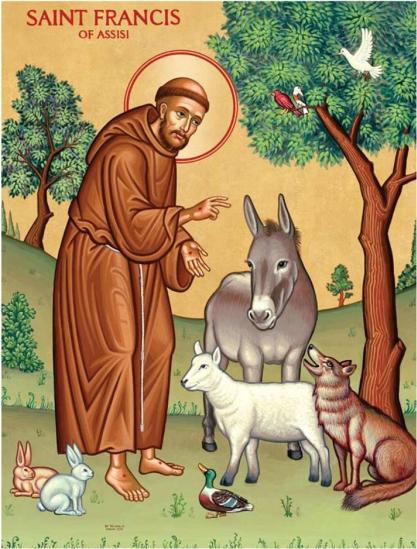St Francis of Assisi
 The most remarkable man of the Middle Ages was born Giovanni di Pietro di Bernardone to a prosperous merchant and his wife in central Italy in 1181. His father nicknamed him Francesco (”Frenchy”) and so the young man became known to history as Francis of Assisi.
The most remarkable man of the Middle Ages was born Giovanni di Pietro di Bernardone to a prosperous merchant and his wife in central Italy in 1181. His father nicknamed him Francesco (”Frenchy”) and so the young man became known to history as Francis of Assisi.
After living the carefree life of a rich man’s son, Francis underwent a series of religious experiences that caused him to renounce his father’s wealth and to embrace a life of poverty and service. He begged for his keep, tended to lepers, and preached a message of love and repentance across the local countryside. (He also preached to the birds and fish, urging them to be grateful to God.) Francis travelled widely and even went on the Sixth Crusade where he preached to the politely attentive Sultan of Egypt. Despite his radical approach to property and the environment, Francis attracted large numbers of followers who were eventually organized in the Order of Friars Minor (the Franciscans, for men) and the Order of St Clare (for women).
The tender heart of Francis naturally found expression in his attitude toward Christmas. In 1220 in the town of Greccio, Francis set up the earliest living nativity scene. (From “Greccio” we get the word “crèche”.) It had been customary for centuries for churches to set up a model of a crib near the altar during the Christmas season but Francis was the first to use real animals, a donkey and an ox, a manger full of straw, and a tiny baby to bring home the long-ago events in Bethlehem and makie the Incarnation and humanity of Jesus real to the ordinary people.
Then he prepared a manger, and brought hay, and an ox and an ass to the place appointed. The brethren were summoned, the people ran together, the forest resounded with their voices, and that venerable night was made glorious by many and brilliant lights and sonorous psalms of praise. The man of God [St. Francis] stood before the manger, full of devotion and piety, bathed in tears and radiant with joy; the Holy Gospel was chanted by Francis, the Levite of Christ. Then he preached to the people around the nativity of the poor King; and being unable to utter His name for the tenderness of His love, He called Him the Babe of Bethlehem. A certain valiant and veracious soldier, Master John of Grecio, who, for the love of Christ, had left the warfare of this world, and become a dear friend of this holy man, affirmed that he beheld an Infant so marvelous sleeping in the manger, Whom the blessed Father Francis embraced with both his arms, as if he would awake Him from sleep.
The living Nativity scene is a long-enduring tradition that is still carried out 800 years later.
Another Christmastide example set by Francis that is still observed is the custom of giving animals a special feeding on December 25. He begged farmers to give their livestock extra food at Christmas in memory of the ox and ass between whom the Baby lay. “If I could see the Emperor,” he said, “I would implore him to issue a general decree that all people who are able to do so, shall throw grain and corn upon the streets, so that on this great feast day the birds might have enough to eat, especially our sisters, the larks.” To this day, Norwegians will set out a julenek, a sort of Bird’s Christmas Tree, to provide grain for our winged friends. English farmers may wassail their cattle with an anointing of cider and Polish farmers on Christmas Eve give their cattle an oplatek wafer and bless them with the sign of the cross.
The Franciscan brotherhood is also responsible for the idea of Christmas carols. Before the 1200s most songs celebrating Advent and the Nativity were solemn, theologically-dense hymns in Latin but members of the order took popular tunes – often dance music — and wrote lyrics in the local language.